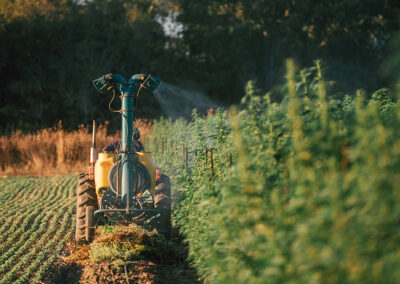Drip tape is a versatile and efficient drip irrigation tool that is used by most farmers and growers. Its ability to provide controlled and precise water distribution directly to the plant’s root zone makes it an ideal choice for various crop types. Let’s explore the benefits and considerations of using drip tape irrigation for cannabis.
Choosing Drip Tape Options
When selecting drip tape, there are several variables to consider. The most common ones include tape thickness, ranging from 5mm to 10mm, and emitter spacing, typically ranging from 4″ to 12″. It is also recommended to opt for pressure-compensating drip tape, especially when distributing liquid fertilizers to ensure even dispersion throughout the crop.
Applying Drip Tape for Different Crop Types
The application of drip tape will vary depending on the crop’s growth stage and density. For auto-flowering crops, using one line of drip tape per line of plants is recommended, with emitter spacing set at 4″ or 8″. This spacing allows for a quick and uniform water distribution, unlike the 12″ spacing, which may require a longer irrigation cycle to achieve the same level of uniformity. For semi-full and full-term crops, whether from clones or seedlings, it is advisable to use two lines of drip tape per row of plants with the same emitter spacing of 4″ or 8″.
Considerations for Plant Densities and Root Growth
Depending on the plant densities per acre, it is worth considering moving the drip tape lines away from the plants once or twice during the crop cycle. This practice encourages root growth and ensures that shallow-rooted clones have sufficient access to water. It is important to bear in mind the variations in root depth between plants grown from clones and plants grown from seeds when determining the placement of drip lines.
Subsurface Drip Tape
While subsurface drip tape is more commonly used in perennial crops like alfalfa, which require long-term irrigation, some farmers are exploring its application in annual crops. Typically, subsurface drip tape is buried around 12″ deep and can be used for multiple seasons. However, its usage in annual crops is less prevalent due to the tillage-intensive nature of annual crop cultivation. Buried drip tape placed at a depth of 1″ to 4″ is being experimented with by some farmers, although the success may vary based on soil types.
Drip tape irrigation provides a practical and efficient solution for crop irrigation, ensuring precise water distribution and improved plant health. When selecting drip tape options, consider tape thickness, emitter spacing, and pressure compensation. Tailor the application of drip tape based on the crop type and growth stage, and make adjustments for plant densities and root growth promotion. While subsurface drip tape offers long-term benefits, its usage in annual crops requires careful evaluation based on soil types and farming practices. By harnessing the power of drip tape, farmers can optimize their irrigation practices and contribute to improved crop yields.

